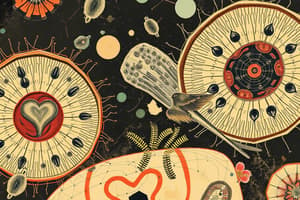Podcast
Questions and Answers
What is the term for rod-shaped cell structures that convert energy in food molecules to energy the cell can use?
What is the term for rod-shaped cell structures that convert energy in food molecules to energy the cell can use?
Mitochondria
What is the function of the cell membrane?
What is the function of the cell membrane?
Controls which substances can enter or leave the cell.
What is cytoplasm?
What is cytoplasm?
The region between the cell membrane and the nucleus.
What is the function of the nucleus?
What is the function of the nucleus?
What is a vacuole?
What is a vacuole?
What is the rough endoplasmic reticulum?
What is the rough endoplasmic reticulum?
What are Golgi bodies?
What are Golgi bodies?
What are ribosomes?
What are ribosomes?
What is the basic unit of structure and function in living things?
What is the basic unit of structure and function in living things?
What instrument makes it possible for people to study cells?
What instrument makes it possible for people to study cells?
How do you calculate the total magnification of a light microscope?
How do you calculate the total magnification of a light microscope?
What did Robert Hooke do?
What did Robert Hooke do?
What did Anton van Leeuwenhoek discover?
What did Anton van Leeuwenhoek discover?
What is a compound microscope?
What is a compound microscope?
What does magnification mean?
What does magnification mean?
What is resolution in microscopy?
What is resolution in microscopy?
What is an electron microscope?
What is an electron microscope?
What is an organelle?
What is an organelle?
What is the cell wall?
What is the cell wall?
How are cells organized in a many-celled organism?
How are cells organized in a many-celled organism?
In a many-celled organism, do all cells look the same?
In a many-celled organism, do all cells look the same?
Describe bacterial cells.
Describe bacterial cells.
Flashcards are hidden until you start studying
Study Notes
Key Cell Structures and Functions
- Mitochondria: Rod-shaped organelles that convert energy from food into usable energy for the cell.
- Cell Membrane: Selectively permeable barrier that regulates the entry and exit of substances within the cell.
- Cytoplasm: The jelly-like material inside the cell where various organelles are suspended, located between the cell membrane and nucleus.
- Nucleus: Control center of the cell that houses nucleic acids and directs cell activities.
- Vacuole: Membrane-bound sac within the cell that functions as a storage area for various substances.
Organelles and Their Roles
- Rough Endoplasmic Reticulum (RER): Network of membranes studded with ribosomes; functions in protein synthesis and transportation.
- Golgi Bodies: Organelles that modify, package, and distribute proteins and lipids received from the endoplasmic reticulum.
- Ribosomes: Small structures found in the cytoplasm and on rough ER, responsible for synthesizing proteins.
Understanding Cells
- Cell: The fundamental unit of structure and function in living organisms.
- Organelles: Specialized structures within a cell that perform distinct functions.
Microscopy and Cell Theory
- Microscope: Device that magnifies small objects, allowing for the study of cells.
- Cell Theory: Fundamental principle stating that all living things are composed of cells, cells are the basic structural units of life, and all cells arise from pre-existing cells.
History of Microscopy
- Robert Hooke: Inventor of the first compound microscope; coined the term "cells" after observing cork.
- Anton van Leeuwenhoek: Gained recognition for discovering diverse one-celled organisms by examining lake water and scrapings.
Types of Microscopes
- Compound Microscope: Uses multiple lenses to magnify small objects.
- Electron Microscope: Utilizes a beam of electrons for high-resolution images, capable of viewing very small specimens.
Key Terms in Microscopy
- Magnification: The degree to which an object’s image is enlarged.
- Resolution: Ability to distinctly identify individual components of an object.
Plant and Bacterial Cells
- Chloroplast: Organelle in plant cells that captures sunlight to produce food through photosynthesis.
- Cell Wall: Rigid structure surrounding plant cells that provides support and protection; allows gas and water permeability.
- Bacterial Cells: Possess a cell wall and membrane, lack a nucleus; genetic material is freely floating in cytoplasm.
Cell Organization in Multicellular Organisms
- Cells differentiate into specialized types to perform distinct functions, forming tissues, organs, and organ systems.
- Diverse cell shapes and structures reflect their specialized roles; for instance, red blood cells differ significantly from nerve cells.
Additional Organelles
- Endoplasmic Reticulum (ER): Network facilitating the transport of proteins and other materials; can be rough (with ribosomes) or smooth (without ribosomes).
- Lysosome: Contains enzymes that break down waste materials and cellular debris within the cell.
Storage Within Cells
- Vacuole: Sac-like structure for storing nutrients, waste products, and other materials needed by the cell.
Studying That Suits You
Use AI to generate personalized quizzes and flashcards to suit your learning preferences.




